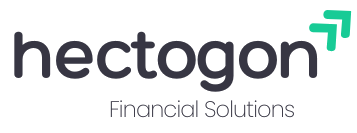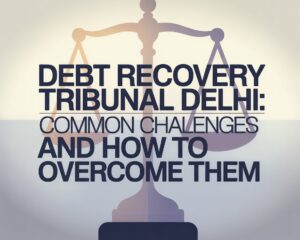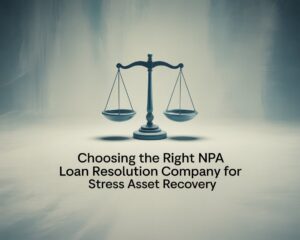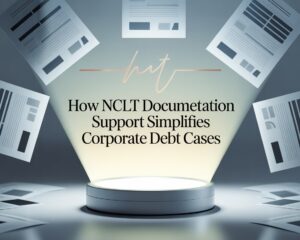Introduction
Defaulted loans and banking disputes can impact your bank account heavily. They can also affect your financial statements. From jeopardising expansion plans and disrupting cash flows to even tying up your valuable assets, the risk associated with them is heavy.
For lenders, delayed loan recoveries aren’t just a setback. They stall reinvestment, block new lending, and weaken portfolio growth. Even for borrowers, the cost is clear. It causes a loss of reputation, assets and extended uncertainty. The consequences of loan defaults and banking issues are severe. A structured and effective way to address these problems is critical.
One such solution already exists for unresolved loan default cases in India. The DRT.
In a nutshell, The Indian DRT works for the long term growth and stability of borrowers and lenders alike. But what is the debt recovery tribunal and how does the DRT work? Let’s find out.
The DRT is a dedicated forum established to resolve loan default issues. It was founded to manage high-value financial disputes. Unlike civil courts, it works faster and focuses only on debt and banking issues.
What is the DRT ?
The Debt Recovery Tribunal is a quasi-judicial body set up under the Recovery of Debts Due to Banks and Financial Institutions Act, 1993. It deals only with loan recovery disputes where the claim amount is ₹20 lakh or more.
Before the DRT, debt recovery meant wasting years of litigation in civil courts.
For banks and borrowers, the slow functioning of traditional courts caused various inconveniences. It resulted in unresolved cases and mounting losses, while prolonging uncertainty. This practice changed in 1993 with the establishment of the DRT.
The role of DRT in loan default cases is:
- Solving debt recovery cases quickly.
- Reducing the backlog in civil courts.
- Maintaining an expert body in banking and finance law.
In short, it is a forum where banks and financial institutions can recover their dues from defaulting borrowers via a faster and more streamlined process than regular courts.
How DRT Works
If you are a lender recovering capital, an investor examining NPAs, or a business owner defending against a claim, understanding the meaning and functions of DRT in banking is essential for you.
It’s a lot more than a legal formality. It empowers you to preserve your capital, get a speedy resolution and secure a fair and unbiased resolution. The debt recovery process in DRT ensures quick decision-making, maintains liquidity for the banking sector, and keeps credit cycles moving.
The Debt Recovery Tribunal (DRT) exists to resolve strictly high-value loan default cases unlike the civil courts and their delays. For lenders, this means faster capital recovery. For borrowers, it’s a direct and streamlined way to present their case and defend themselves before any action is taken.
Here’s how it works:
1. Filing the Application
Banks or financial institutions file an Original Application (OA) with the DRT, stating the amount due and proof of default. Under the SARFAESI Act, borrowers can also file to challenge lenders’ actions in case of disputes.
2. Notice and Hearing
Once the case is admitted, the DRT issues a notice to the borrower. Both parties present their evidence, contracts, and financial records. The process is quick moving, with minimal adjournments.
3. Decision and Recovery
If the lender’s claim is proven, the Presiding Officer issues a Recovery Certificate. This allows the Recovery Officer to attach or sell assets so that the debt recovery process moves forward without further court delays.
This is where the real value of DRT lies, in regulating recovery timelines with business needs, reducing uncertainty in lending cycles, and helping investors, developers, and business owners make faster and better informed decisions.
Role of DRT in Loan Default Cases
The Debt Recovery Tribunal solves loan disputes with a clear and actionable legal pathway. Unlike civil courts where recovering loan defaults takes years, a DRT must complete the case within 180 days. .
The DRT gives lenders the authority to recover their dues with a clear, step-wise process. Without its interference, many cases would still be stuck in litigation for years.
For borrowers, it demands the right to be heard. Every filed case must go through an ordered hearing before any recovery action is taken.
In many cases, the tribunal encourages a settlement between both the parties before the final order is announced. This is done with the aim of saving both time and cost for both. It strives for an immediate resolution for the lender and a frugal outcome for the borrower.
In essence, the DRT’s role is to balance two priorities: Implementing lenders to act on defaults, and assuring borrowers have a fair chance to defend their case.
The DRT process – from filing to recovery
For anyone dealing with a loan dispute, understanding how the Debt Recovery Tribunal works is critical. The resolution process is designed to keep recovery quick but also fair to both sides.
1. Application to the Tribunal
The process begins when a lender, usually a bank or financial institution, files an Original Application (OA) with the DRT. This application includes the debt amount, proof of default, and the mandatory court fee.
2. Summons to the Borrower
The Tribunal issues a summons to the borrower. It asks them to explain within 30 days why the lender’s claim should not be accepted.
- If the borrower appears, the case moves to the written statement stage, where they file their defence.
- If they don’t appear, the case can proceed ex-parte, which means the Tribunal decides based entirely on the lender’s evidence.
3. Evidence Stage
Both sides present their evidence, typically in the form of sworn affidavits.The Presiding Officer over a particular case may demand cross examination of evidence, if required. This keeps the process moving without unnecessary delays.
4. Arguments and Decision
After evidence is submitted, both parties present their oral or written arguments. After judging all the evidence and arguments, the Presiding Officer passes an order either upholding the lender’s claim or dismissing it.
5. Recovery Certificate
If the lender wins, the Tribunal issues a Recovery Certificate to the Recovery Officer. This document has legal force and allows:
- Attachment and sale of the borrower’s movable or immovable assets.
- Appointment of a receiver to manage assets until the debt is recovered.
6. Appeals
Any party dissatisfied with the order can appeal to the Appellate Tribunal within 45 days. Appealing borrowers may need to deposit 75% of the debt amount determined by the Tribunal. However, this can be reduced or waived in certain cases with reasons recorded.
The debt recovery process in DRT is not just about quick resolution, it assures lenders get a clear path to recover dues while borrowers get an opportunity to defend their case.
The Takeaway
The DRT is more than a legal shortcut. It’s a dedicated forum that keeps debt disputes moving and protects the interests of both lenders and borrowers. It ensures timely recovery and better liquidity for lenders. For borrowers, it ensures a fair hearing before any recovery action is taken.
Whether you’re a lender or a borrower, knowing the DRT and how it works can help you prepare better, act faster, and make informed decisions if you’re stuck in a loan default case. In a financial landscape where time is money, the DRT ensures neither is wasted.
FAQs
What is the DRT in banking?
In banking, the Debt Recovery Tribunal (DRT) is a dedicated legal body that deals with loan default cases where the claim amount is ₹20 lakh or more. Its main function is to help banks and financial institutions recover dues from defaulting borrowers quickly, without the delays of regular civil courts.
How many DRTs are in India?
India currently has 39 Debt Recovery Tribunals (DRTs) spread across different states for efficient loan recovery.
What is OA in DRT?
An OA is the formal application a bank or financial institution files with the DTR. Filing an OA starts the recovery process against a defaulting borrower. The OA includes the claim amount, proof of default, and a court fee, and marks the official start of DRT proceedings.
What is the difference between DRT and DRAT?
The DRT is a specialised body that resolves loan default and debt recovery cases. If either side isn’t satisfied with its decision, they can move to the DRAT, a higher body, which hears appeals against DRT orders within 45 days from the DRT’s decision.








